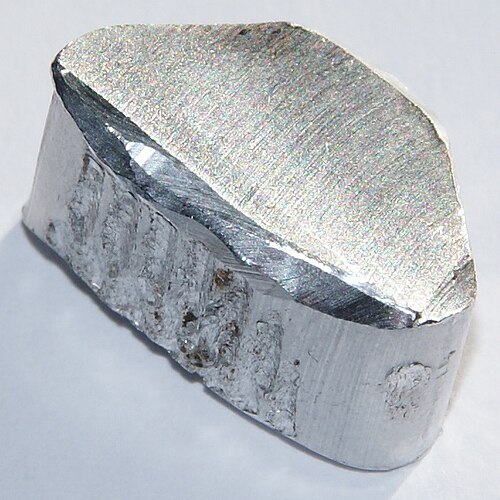Aluminiumnoun
A light, silvery metal extracted from bauxite, and a chemical element (symbol Al) with an atomic number of 13.
Aluminiumnoun
(countable) A single atom of this element.
Aluminiumnoun
same as aluminum, chiefly British in usage.
Aluminiumnoun
a silvery ductile metallic element found primarily in bauxite
Tinnoun
(uncountable) A malleable, ductile, metallic element, resistant to corrosion, with atomic number 50 and symbol Sn.
Tinnoun
An airtight container, made of tin or another metal, used to preserve food.
Tinnoun
(countable) A metal pan used for baking, roasting, etc.
Tinnoun
The bottom part of the front wall, which is "out" if a player strikes it with the ball.
Tinnoun
money
Tinnoun
Computer hardware.
Tinadjective
Made of tin.
Tinadjective
Made of galvanised iron or built of corrugated iron.
Tinverb
(transitive) To place into a tin in order to preserve.
Tinverb
(transitive) To cover with tin.
Tinverb
(transitive) To coat with solder in preparation for soldering.
Tinnoun
An elementary substance found as an oxide in the mineral cassiterite, and reduced as a soft silvery-white crystalline metal, with a tinge of yellowish-blue, and a high luster. It is malleable at ordinary temperatures, but brittle when heated. It is softer than gold and can be beaten out into very thin strips called tinfoil. It is ductile at 2120, when it can be drawn out into wire which is not very tenacious; it melts at 4420, and at a higher temperature burns with a brilliant white light. Air and moisture act on tin very slightly. The peculiar properties of tin, especially its malleability, its brilliancy and the slowness with which it rusts make it very serviceable. With other metals it forms valuable alloys, as bronze, gun metal, bell metal, pewter and solder. It is not easily oxidized in the air, and is used chiefly to coat iron to protect it from rusting, in the form of tin foil with mercury to form the reflective surface of mirrors, and in solder, bronze, speculum metal, and other alloys. Its compounds are designated as stannous, or stannic. Symbol Sn (Stannum). Atomic weight 117.4.
Tinnoun
Thin plates of iron covered with tin; tin plate.
Tinnoun
Money.
Tinverb
To cover with tin or tinned iron, or to overlay with tin foil.
Tinnoun
a silvery malleable metallic element that resists corrosion; used in many alloys and to coat other metals to prevent corrosion; obtained chiefly from cassiterite where it occurs as tin oxide
Tinnoun
metal container for storing dry foods such as tea or flour
Tinnoun
airtight sealed metal container for food or drink or paint etc.
Tinverb
plate with tin
Tinverb
preserve in a can or tin;
Tinverb
prepare (a metal) for soldering or brazing by applying a thin layer of solder to the surface
Tin
Tin is a chemical element with the symbol Sn (from Latin: stannum) and atomic number 50. Tin is a silvery metal that characteristically has a faint yellow hue.







































